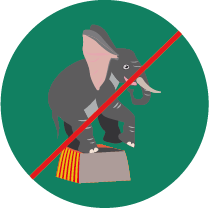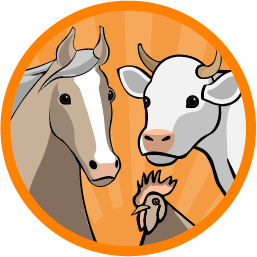Today, the notion of animal welfare is everywhere: in consumer and citizen expectations but also in the various specifications, regulations, marketing initiatives, farming systems…
But recognition of the sensitive nature of animals and their ability to feel emotions goes back a long way. Scroll down to discover some key dates in the history of animal welfare awareness and regulation!

Regulatory milestones

Scientific milestones

The philosophical tradition

During the Enlightenment, the notion of « sensitive animal » appeared in the Discourse on the Origin and Basis of Inequality Among Men:
« It appears, in fact, that if I am bound to do no injury to my fellow-creatures, this is less because they are rational than because they are sentient beings: and this quality, being common both to men and beasts, ought to entitle the latter at least to the privilege of not being want only ill-treated by the former »

At the same time, the English philosopher wrote about animals in his Introduction to the Principles of Morals and Legislation:
"The question is not, ‘Can they reason?’ nor ‘Can they speak?’ but ‘Can they suffer?’"
1824: Creation of the first animal protection association in the United Kingdom, the Society for the Prevention of Cruelty to Animals.
It was quickly followed by the creation of the SPA (Animal Protection Society) in France in 1845 by Etienne Pariset. His first fight was the protection of horses mistreated by Parisian coachmen.
It is the first animal protection law

It wasn't until 1959, with the Michelet decree, that abuse in private was also condemned.
The founding texts
 In their book on the ethical treatment of laboratory animals, « Principles of Human Experimental Technique, » these two biologists outlined the 3Rs: Replacement of animals in research, Reduction of the number of animals used, and Refinement of experiments whenever possible.
In their book on the ethical treatment of laboratory animals, « Principles of Human Experimental Technique, » these two biologists outlined the 3Rs: Replacement of animals in research, Reduction of the number of animals used, and Refinement of experiments whenever possible.
 She published a reference book on farm animals: « Animal Machines, The New Factory Farming Industry » where she denounced living conditions in intensive animal farming.
She published a reference book on farm animals: « Animal Machines, The New Factory Farming Industry » where she denounced living conditions in intensive animal farming.
 This report defines the basic needs of farm animals to be fulfilled. It is the basis for the 5 freedoms and the modern assessment of animal welfare.
This report defines the basic needs of farm animals to be fulfilled. It is the basis for the 5 freedoms and the modern assessment of animal welfare.
 Peter Singer published « Animal Liberation », which had a founding role in the development of the animal rights movement.
Peter Singer published « Animal Liberation », which had a founding role in the development of the animal rights movement.
The notion of sensitive being appears in the rural code’s law of July 10, 1976:
Article L214.1: “Any animal as a sensitive being must be placed by its owner in conditions compatible with the biological imperatives of its species”.
5 fundamental freedoms are formulated by the FAWC (Farm Animal Welfare Council) and define the conditions to ensure animal welfare:
- No hunger or thirst
- No discomfort
- Absence of pain, injury or illness
- Freedom to express species-specific behaviors
- Absence of fear and anxiety
They provide an operational framework for assessing animal welfare. Other operational definitions are used, notably the one developed by the Welfare Quality® protocol.
Treaty of Amsterdam
From « commodities » in the Treaty of Rome in 1957, animals became "sentient beings" :
« In formulating and implementing the Union’s agriculture, fisheries, transport, internal market, research and technological development and space policies, the Union and the Member States shall, since animals are sentient beings, pay full regard to the welfare requirements of animals ».
They are transposed into national law and must be applied in farms on a daily basis. Read to know more about them.
1998: General directive for the protection of animals in all types of breeding
The 1998 directive imposes minimum standards on housing and practices. It was revised in 2000 for pigs, broilers and calves. It is an obligation of means.
From 2007 onwards, an obligation to achieve results has been gradually introduced. The directive on the protection of broilers was the first to introduce animal based indicators, and has led to changes in housing conditions for broilers to better take account of the species' needs.
Many other specific European directives exist alongside these.
Between 2004 and 2009, the Welfare Quality® research project was launched in Europe. Its aim is to define a harmonized system for assessing animal welfare on farms and in slaughterhouses.
According to this protocol, 4 principles of welfare are assessed (good food, good housing, good health, appropriate behavior), themselves broken down into 12 operational criteria.
The law of February 16, 2015 introduces into the Civil Code the concept that animals are living beings “endowed with sensitivity”.
The aim of this strategy is to place animal welfare at the heart of a sustainable farming. To achieve this, 20 priority actions have been identified around 5 key areas.
The 5 lines of action :
1. Sharing knowledge and promoting innovation
2017: Creation in France of the French National Reference Center for Animal Welfare (CNR). Bringing together INRAE, agricultural technical institutes, veterinary schools and ANSES, this center works on all species.
2. Empowering players at all levels
3. Pursue the development of more animal-friendly production practices
4. Preventing and responding to animal abuse
5. Keep everyone informed of the progress and results of the action plan.
Following European Regulation n°217/625 of March 15, 2017, 4 European Reference Centers for animal welfare are gradually being created, each with a particular focus on specific species:
- 2018: creation of the “EURCAW Pigs” center, working on pigs
- 2020: creation of the “EURCAW Poultry and other small farmed animals” center, working on poultry and other small farmed animals.
- 2021: creation of the “EURCAW Ruminants and Equines” center, working on ruminants and equines.
- 2024: creation of the “EURCAW Aquatic Animals” center, working on aquatic animals
The Chaire Bien-être Animal, a partnership between VetAgro Sup and the DGAL is created in 2018!
Law of November 30, 2021against animal abuse carried by Loïc Dombreval and Anne Chain-Larché - 3 main axes:
1. Combating pet abandonment:
- Increased criminal penalties for abandonment, now classified as an offence punishable by 3 years' imprisonment and a €45,000 fine.
- Requirement for individuals to sign a certificate of commitment and knowledge prior to adoption
- Ban on the sale of cats and dogs in pet shops (to come into force in 2024)
2. Tougher penalties for pet abuse
3. Phase out the use of wild animals in traveling circuses and dolphinariums
Find out more about the law here



Farm to Fork is a European strategy adopted in 2021 as part of the Green Deal for Europe. Among its objectives is the revision of European directives on animal welfare, based on the latest scientific data.
The European Commission has announced a legislative proposal to phase out cage farming for all species.
January 2022: Ministerial order banning live castration of piglets comes into force.
Breeders are no longer allowed to castrate piglets (live or otherwise), which must be carried out by a veterinarian, unless an exemption is granted.
Find out more here
February 2022: Decree banning the crushing or gassing of male chicks in the laying hen industry.
This ban does not apply to male chicks intended for animal feed, or to chicks hatched from white eggs: the latter can no longer be crushed, but must be gassed.
Find out more here
Since 2022, all farms with domestic animals (livestock and pets) and wild animals that have been tamed or kept in captivity must appoint an animal welfare officer. The role of the animal welfare officer is to raise awareness of animal welfare issues among people working in contact with animals.
3 new parts of the European Farm to Fork Strategy (European Green Deal) have been proposed. However, the majority of the texts have not yet been adopted and therefore not yet implemented.
One aspect of the plan involves improving the rules for transporting live animals (limiting journey times, allowing breaks outside the vehicle during long journeys, increasing minimum space and prohibiting transport during extreme temperatures).
The directives implementing the European strategy are based on scientific opinions issued by the European Food Safety Authority (EFSA).

